Archive for the ‘creativity prompt’ Category
Friday, January 2nd, 2009
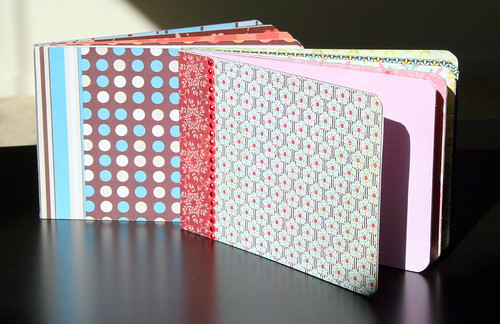
On December 4th my husband and I landed in California after an 11 hours flight and were welcomed by our wonderful friends. They’d hosted us for over a week, until we found an apartment, and drove us around for all our initial errands. I am very thankful for their help and hospitality. On one of our first shopping sprees, Andrea, my good friend, has introduced me to the one dollar bin at Target, where we bought a children’s chipboard book.
The idea of altering a children’s chipboard book has sat in my mind for quite a while and as soon as I saw these one dollar books at Target, I knew I have a project at hand. I made Andrea buy one as well, so she would join me for the “craft-session” and I enjoyed her talented company a lot.
So for this week’s creativity prompt I will show you how I turned this:
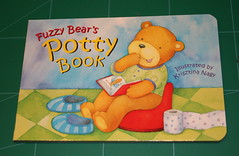
Into that:
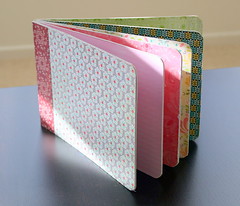
Supply –
- Chipboard book.
- Patterned paper.
- Glue stick.
- Craft Knife & Cutting mat.
- Ruler.
- Bone folder or a paper trimmer with a scoring blade.
Step By Step Instructions –
- First, measure the size of each page, the spine and the page fold. Write down the numbers on a scrap of paper.
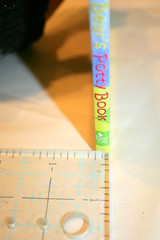
The Spine.
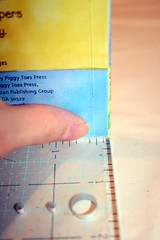
The Page Fold.
- Cut the patterned paper to the page’s size and adhere them on each of the book’s pages with a generous amount of glue stick. Make sure that the glue is completely dry before moving to the next page, otherwise, the pages will stick together and tear.
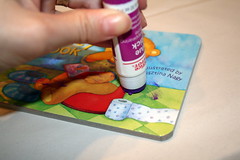
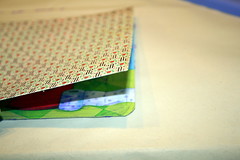
- After adhering each patterned paper, flip the book and cut the excess paper with a sharp craft knife. Make sure not to glue two papers to both sides of the same page before cropping the excess out!
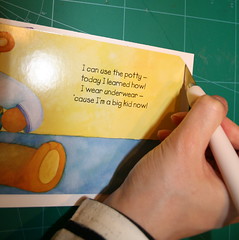
- When applying the patterned paper to the cover, stop at the first score mark on each page. (One is probably flash with the spine and the other with the page’s fold.)
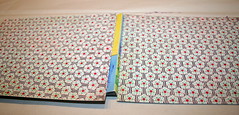
- To conceal the spine start by trimming a patterned paper to the same height of the book and 2″ wider than the spine.
- Next, score the strip at 1″ on each side (lengthwise) – that should create the spine’s score lines.
- Then score the strip again on one side at the same size of the page’s fold that you have measured on step 1. Make the score line, measuring from the spine’s score line to the edge.
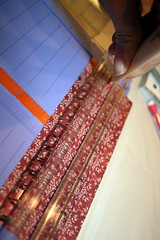
You should end up with a strip of patterned paper which looks like that:
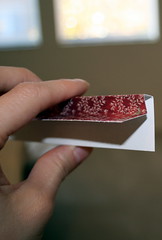
- Glue the patterned paper strip to the book, using a glue stick.
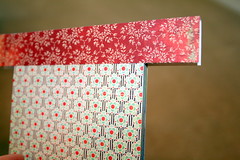
- Cut the excess with a craft knife.
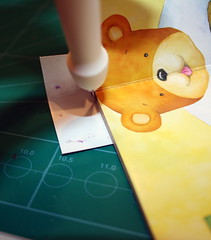
Voilà ! You are done and free to embellish the altered book as you wish.
Enjoy!!!
If you have any question, suggestion or remark – don’t hesitate to contact me – either leave a comment, use the contact form or start a new thread on the Creativity Prompt Flickr Group!!!
I would also be very happy to see your own altered books, so don’t be shy and share 🙂
Posted in creativity prompt, Tutorial | 27 Comments »
Friday, December 26th, 2008
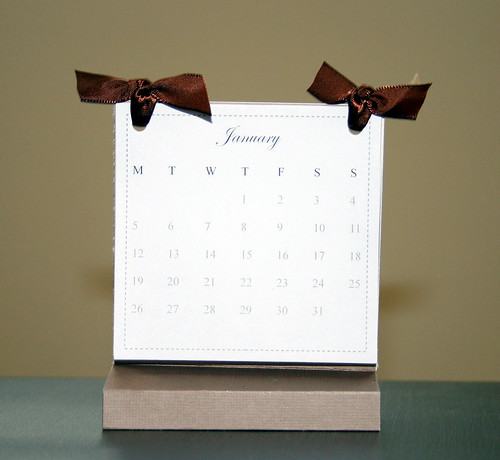
The year 2008 is coming to an end. It is time to start planing the glorious 2009 which is right at the corner. Wouldn’t it be wonderful to start the year to come with a handmade calendar, to stand beside you as a reminder of how awesome you are all year long. If you are interested – keep on reading for a step-by-step instructions and a FREE 2009 Calendar download.
Supply –
- 2009 Calendar template (download by clicking on the link above).
- Cardstock
- Double Sided Tape
- Loose leaf rings/ribbon (I prefer the rings, but I didn’t have any at home, so I used Paper Trey’s ribbon instead)
Tools –
- Paper trimmer
- Bone folder
- Ruler + craft knife + cutting mat
Step By Step Instructions –
- Print the calendar template (either on cardstock or a regular copy-paper). Cut down the individual months’ boxes with an 1/8″ margin from the dashed frame. Use the marks on your ruler for the alignment and cut with a craft knife.
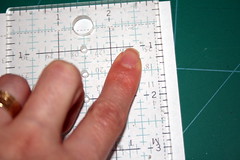
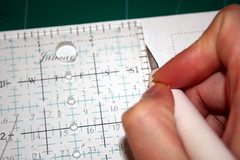
Work on each of the printed pages individually, as they are not perfectly aligned to each other.
- Cut your cardstock at 3½” by 12″.
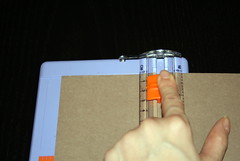
- Score your cardtock strip (widthwise) at: 3½”, 4½”, 5″, 7″, 7½”, 8½”. I used the paper trimmer and a bone folder for the scoring.
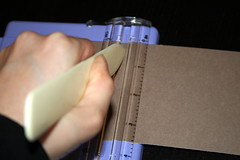
- Fold all the score lines and burnish with the bone folder.
- Apply two strips of strong double sided tape to both ends of one of the 3½” flaps. It doesn’t matter which of them you choose to apply the tape to.
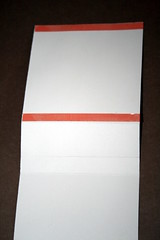
- Align both 3½” flaps together and adhere them. That should form the calendar’s stand.
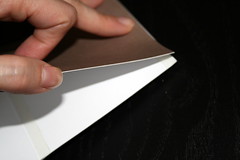
- Group all the months’ boxes together and align them on the top flap of the calendar’s stand. Punch 2 holes right below the top edges of the dashed frame. (I was using a crop-a-dile).
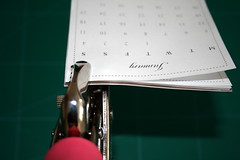
- Attach all the layers together with the loose-leaf rings or the ribbon and you are done!!!
Enjoy!!!
If you have any question, suggestion or remark – don’t hesitate to contact me – either leave a comment, use the contact form or start a new thread on the Creativity Prompt Flickr Group!!!
I would also be very happy to see your own handmade calendars, so do share 🙂
Tags: calendar, creativity, creativity prompt, Tutorial
Posted in creativity prompt, Tutorial | 10 Comments »
Friday, December 19th, 2008
Christmas & Hanukkah are on their way… There are so many errands to run and so much work to do by then. It isn’t that unusual to get to the holiday cards at the very last minute. Sometime it can be discouraging.
But don’t worry, I have a little secret which helps me to make cards quickly and easily – that means I don’t have to give up on handmade cards for the holidays, even at the last minute.
My secret is very simple – turning my most used and loved scrapbooking layouts into cards. I already know the design is going to work for me so it’s a foolproof system. Who said scraplifting is for scrapbooking only?
For this week’s creativity prompt I ask you to make handmade cards regardless of how close the holidays are getting.
The Layout –
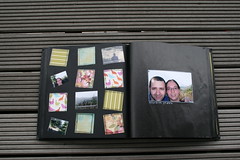
The Cards –
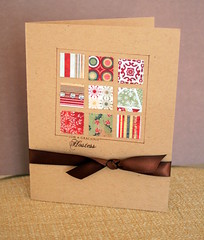
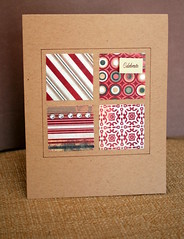
The Layout –
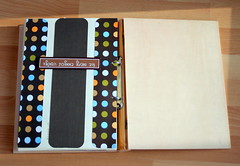
The Cards –
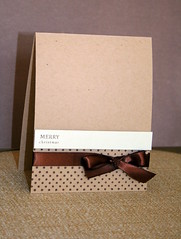
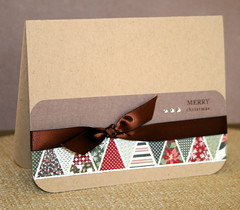
The Layout –
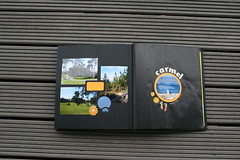
The Cards –
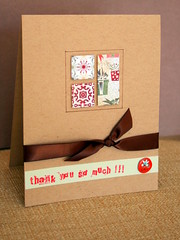
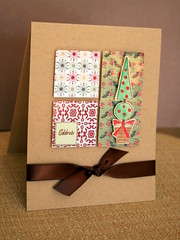
Enjoy!!!
If you have any question, suggestion or remark – don’t hesitate to contact me – either leave a comment, use the contact form or start a new thread on the Creativity Prompt Flickr Group!!!
I would also be very happy to see your holiday card creations, so don’t be shy and share 🙂
Do you have any fast card-making tips?
Related Posts –
- The Complete Guide For Easy Holiday Cards.
- Mini Cards & Envelopes Set.
- Card-Set Holder.
Tags: cards, creativity, creativity prompt, holiday cards
Posted in creativity prompt | Comments Off on Creativity Prompt #30 – Turn Your favorite Layouts Into Holiday Cards
Friday, December 12th, 2008
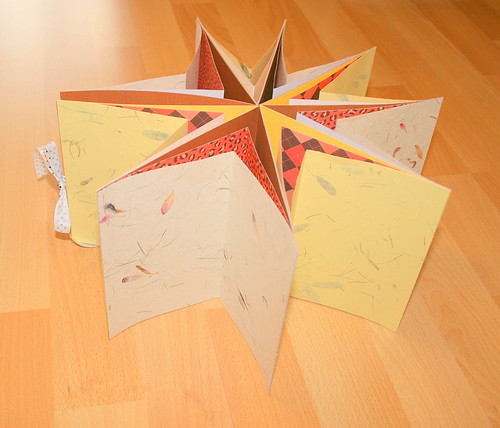
The star album has a strong “WOW” factor as it opens, but it is actually very simple to make one. The secret is in the graduating width of the partitions. For a step by step instructions on how to make this album, keep on reading:
Supply –
- 4 sheets of 12″ by 12″ cardstock.
- 8 sheets of 12″ by 12″ patterned paper (or 16 sheets of 8½” by 11″ pp).
- Tape runner.
- Double sided tape.
- 2 pieces of ribbon, 12″ each.
Tools –
- Paper trimmer.
- Bone folder.
Step by Step Instructions –
- Cut the star’s partitions, as follows:
- 8 pieces of 6″ by 12″ cardstock (just cut your cardstock in half).
- 8 pieces of 6″ by 10″ patterned paper.
- 8 pieces of 6″ by 8″ patterned paper.
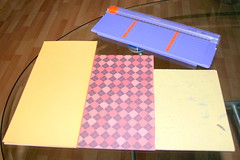
- Fold each piece in half, along its long edge, and burnish well with a bone folder.

- Apply adhesive to the 6″ edges of the patterned papers.
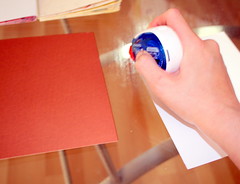
Then attach the partitions together –
First, attach the 6″ by 10″ patterned paper to the 6″ by 12″ cardstock.
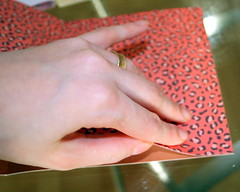
Then attach the 6″ by 8″ patterned paper to the 6″ by 10″ one.
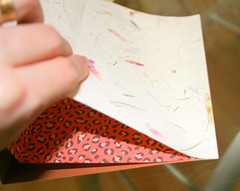
You should end up with this shape –
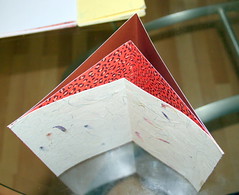
Now repeat, until you’ve got 8 “legs” for building the star.
- After you finish adhering the star’s “legs” – assemble it on your desktop, to make sure everything works well together and to guide you through the next stages.
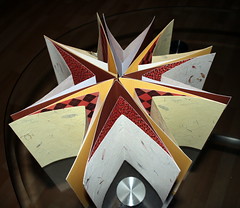
- Pick 2 adjacent “legs” randomly (they are going to become the cover of your album) and apply a double sided tape strip along their midsection.

Note that the adhesive’s strip is bulging out of the creased edge – this is done in order to tuck-in the edges of the ribbon for an elegant and more finished looking closure. Just wrap the access adhesive’s strip over the crease and attach the ribbon to it.
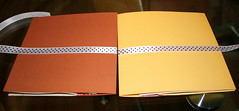
- Next, pick one of the outer “legs” and start attaching each 6″ by 6″ partition to the adjacent one.
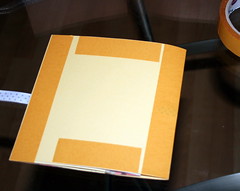
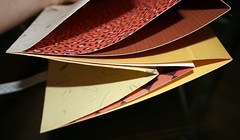
This is when assembling the star’s shape in advance is going to come in handy.
-
Repeat the last stage, until you finish attaching all the star’s partitions to each other. Make sure not to attach the partitions with the ribbon to each other…
A glimpse at the star album while it’s closed:
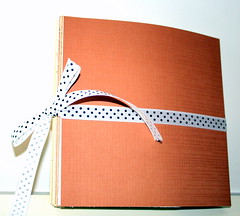
Enjoy!!!
If you have any question, suggestion or remark – don’t hesitate to contact me – either leave a comment, use the contact form or start a new thread on the Creativity Prompt Flickr Group!!!
I would also be very happy to see your own star-album creations, so don’t be shy and share 🙂
Tags: album, creativity, creativity prompt, mini-album, scrapbooking
Posted in creativity prompt, Tutorial | 3 Comments »
Friday, December 5th, 2008
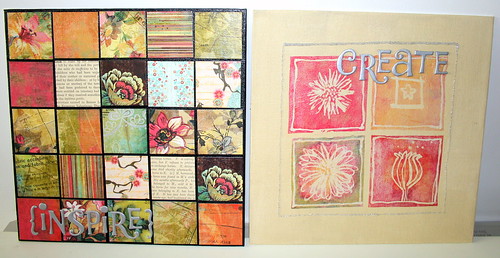
Découpage is a fantastic technique of paper piecing that helps us to create impressive art creations quickly and easily, while actual painting & drawing are unnecessary. This is also a fabulous way to use all your small paper scraps. [or holiday cards’ cut-outs…]
I have been using this technique for quite a while but only recently Meital, a childhood friend of my husband, suggested that I should make a tutorial on this technique, so here you go:
Supply –
Step by Step Instructions –
Napkins Découpage –
- Go through your stash [if you’re like me and you’ve got a stash…] and choose a napkin with an interesting illustration. I chose a napkin with some flower illustrations. Each napkin usually has 4 prints.
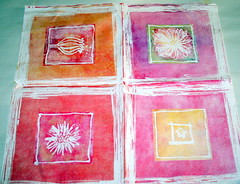
- Next, you need to paint your canvas. Pick a color that goes well with the illustration on your napkin. Using a foam brush, apply an even coat of the acrylic paint to the canvas. [When working with napkins and other light-weight papers it is better to use a very light color, otherwise the illustration will get “absorbed” and lost in the background.]
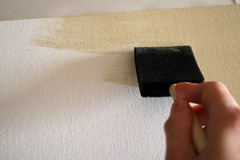
- While the canvas is getting dried, cut the illustration from the napkin and separate its layers so you end up with the very top layer. You can discard the rest of the layers [it’s recyclable!]
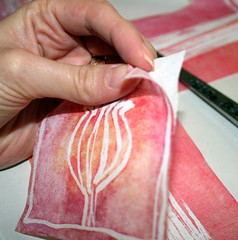
- After the canvas is completely dry arrange your cut-outs on it in a way that pleases your eye. [After applying the glue or the gel medium figuring out the placement of your cut-outs will get trickier.]
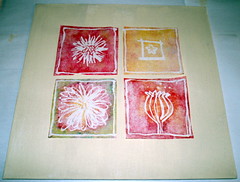
- Then, when you are pleased with the composition, apply the Mod-Podge glue generously with the foam brush both below and above the cut-out, as the glue works as a sealer as well as an adhesive.
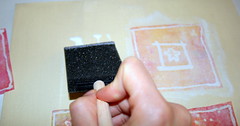
- Repeat the gluing and sealing process with all your cut-outs and make sure you apply an even coat of glue and going with the brush at the same direction all over. When you are finished and the glue has completely dried you can embellish your canvas with alpha stickers and glitter glue or anything else you can think of.

Paper Scraps Découpage –
The process is basically the same, only you can use any color for the background. Therefore I am not going to be as verbose…
- Paint your canvas.
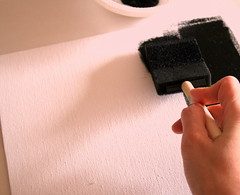
- Choose your scraps and cut to size. On a 10″ by 10″ canvas I used 25 pieces of patterned paper, cut at: 1 7/8″ by 1 7/8″.
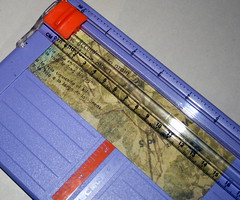
- Figure out the placement of all your paper cut-outs.
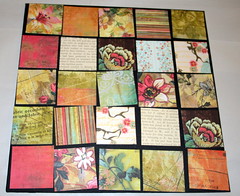
- Apply glue or gel medium below and on top of each piece of paper.
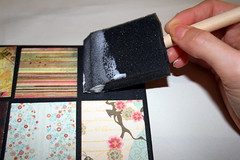
- Finish off your canvas with your favorite embellishments and enjoy your art!
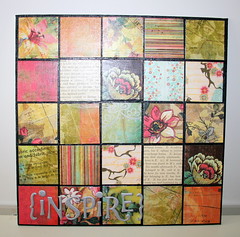
Enjoy!!!
If you have any question, suggestion or remark – don’t hesitate to contact me – either leave a comment, use the contact form or start a new thread on the Creativity Prompt Flickr Group!!!
I would also be very happy to see your artistic creations, so don’t be shy and share 🙂
Tags: art, creativity, creativity prompt, decoupage, Tutorial
Posted in creativity prompt, Tutorial | 11 Comments »
Friday, November 28th, 2008
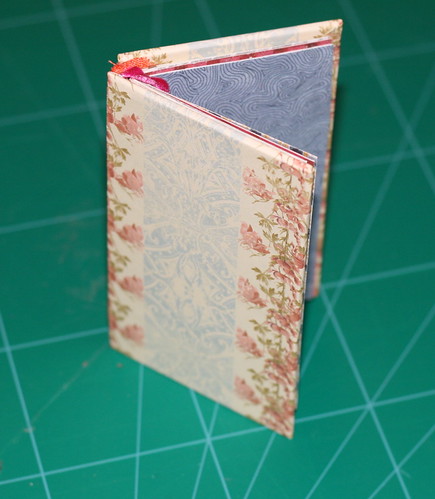
For this weeks creativity prompt I have got a cute project with a unique “measurement method“. If you want to learn how to create this whimsical & colorful mini-book – read on:
Supply –
- Patterned paper
- 2 chipboard scraps. [use the chipboard that comes with your craft supply or with your writing pads or even cut 2 pieces from a cardboard box]
- Ribbon (optional)
- A scrap of fabric for the spine (optional).
- Glue stick
- Double sided tape
- Tape runner
Tools –
- Paper trimmer
- Bone folder
- Ruler
- Craft knife + Self healing mat
- Regular office stapler
Step By Step Instructions –
- To determine the size of the pages – measure the width of your stapler’s “arm”. [I did promise a unique measurement technique…]

- Next, determine the desired height of your mini-book [everything goes] and cut an even number of patterned papers at your desired height and double the width of your stapler’s “arm”.
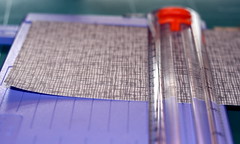
My stapler’s “arm” width was 2¼” and I wanted the height of the mini-book to be 5″, so I cut my patterned papers at 5″ by 4½”
- Adhere every two pieces of patterned paper together – back to back – to create your inserts. [or use double sided cardstock…]
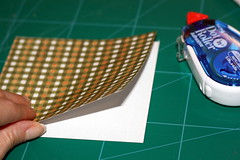
- Score each insert at the midpoint, lengthwise. [It should measure the same as your stapler’s “arm”. Mine is 2¼”.]
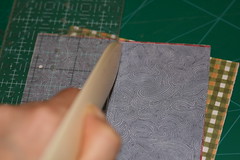
- Stack all your inserts together and staple them twice in the middle crease to create your signature. This is when all your measurements are going to make sense…
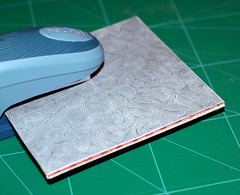
- Next cut your chipboard scraps ¼” taller and wider then each page of your signature. [mine are: 5¼” by 2½”.]
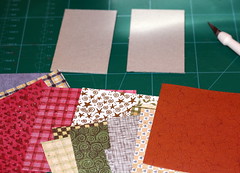
- Now you need to cover your chipboard pieces:
First cut 2 pieces of patterned paper (or fabric) which are at least 1″ taller and wider than your chipboard pieces. Then, using a glue stick, adhere the chipboard pieces in the middle of the patterned paper pieces.
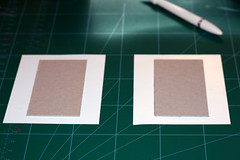
Next, cut all the corners of your patterned paper and create a triangle whose base is about an 1/8″ away from the chipboard’s corners.
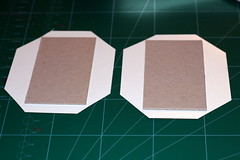
First adhere two flaps which are opposite to each other.
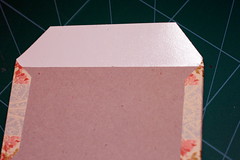
Next, tuck the corners of the remaining flaps with the tip of your bone folder. This is going to give your cover a more professional look.

Adhere the remaining flaps to the chipboard, and your covers are ready.
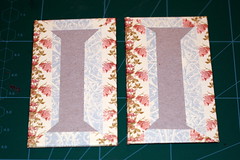
- Adhere a scrap of fabric [the same height as your book – mine is 2″ by 5″] to the inner side of your covers with a strong double sided tape. This is going to become the spine of your mini-book. This step is optional.
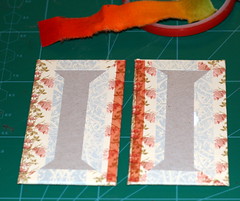
- Adhere the ribbon to the spine – the thinner the ribbon is, the better. This step is also optional and is going to provide your mini book a built-in bookmark.

- Finally, attach the signatures to the cover with a strong double-sided tape and enjoy your colorful mini-book.
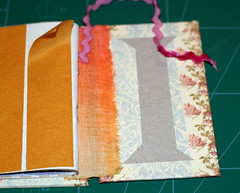
Enjoy!!!
If you have any question, suggestion or remark – don’t hesitate to contact me – either leave a comment, use the contact form or start a new thread on the Creativity Prompt Flickr Group!!!
I would also be very happy to see your own mini-book creations, so don’t be shy and share 🙂
Tags: creativity prompt, journal tutorial, mini-book, Tutorial
Posted in creativity prompt, Tutorial | Comments Off on Creativity Prompt #27 – How To Make A Colorful Mini-Book
Friday, November 21st, 2008
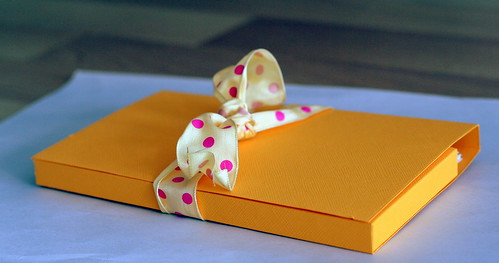
This card set holder is the perfect handmade token of appreciation to anyone you would like to give thanks to. It takes minutes to assemble and you can use inexpensive envelopes which are available at any convenient store and a couple sheets of cardstock (each sheet yields 4 cards, measured 3″ by 6″) and the holder accommodates 5 cards & 5 envelopes. The holder itself is made out of one sheet of cardstock.
So without further ado lets jump right into this week’s tutorial:
Supply –
Instructions –
- Download the card set holder template. Note that the template isn’t scaled but only designed to give you an idea of the measurements of all the folding and cutting that needs to be done. So don’t print out the template.
-
Trim one sheet of cardstock to a 9″ by 12″ piece.
- Along the 12″ side, score your cardstock at 1/2″, 1″ on each side.
- Flip your cardstock to the 9″ side and score at: 4″, 4 1/2″, 8 1/2″, 9″.
- Trim along the one inch score line on each side and keep only the 3″ flap at the very end.

- fold all the scoring lines and burnish with a bone folder.
- Apply double sided tape to the two outer flaps.
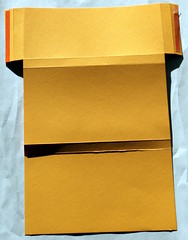
- Adhere the outer flap to the inner part of the first 4″ section of your cardstock. Repeat on both sides. That would form the pocket of your card set holder.
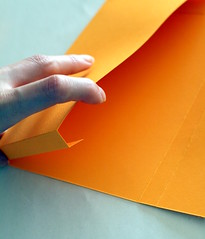
- Use a circle punch to punch out half a circle from the middle of the pocket. That would give your card set holder a finished look.
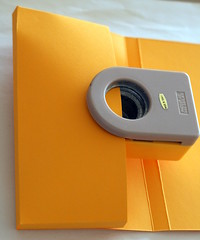
[You could, and perhaps should, punch out the circle before adhering the pocket. It would be much easier to punch your cardstock while it’s still flat…]
- Insert the envelopes and cards inside the pocket and your pretty gift is ready to be given.
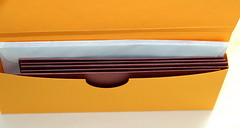
- For an added interest and a finished look you can embellish your cards and envelopes to match by using the same design on both.

Enjoy!!!
If you have any question, suggestion or remark – don’t hesitate to contact me – either leave a comment, use the contact form or start a new thread on the Creativity Prompt Flickr Group!!!
I would also be very happy to see your own creations, so don’t be shy and share 🙂
Tags: cards, creativity, creativity prompt, Tutorial
Posted in creativity prompt, Tutorial | 4 Comments »
Friday, November 14th, 2008

On this week’s creativity prompt I want to share some quick and easy scrapbooking tips. Using those techniques has enabled me to complete visual appealing scrapbooks in the course of one weekend (sometimes in a single day!!!).
I always get overwhelmed with awe while browsing through some scrapbookers’ blogs and public galleries. Their layouts are intricate and artistic and convey hours of meticulous work. However, these scrapbook layouts are not realistic to most people.
In today’s hectic world there is not enough time to achieve these artistic results on a regular basis. Therefore most people just give up along the way and feel guilty or “left behind” in recording their treasured memories.
I want to share some tips & techniques that will help you create visually appealing layouts quickly and adjust your scrapbooking routine to your fast-paced life.
- Focus on the essentials. letting your artistic talent shine through your layouts is great but the main purpose of the scrapbook is to capture your life stories, so concentrate on them. Let the pictures and journaling take center stage.
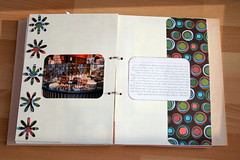
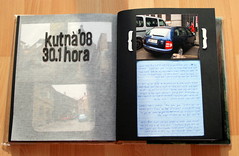
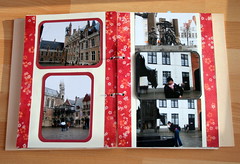
- Use standard size 4″ by 6″ photos. Cropping your photos using a photo-editing software is easy, but it takes time. It is an extra step that sets you back and makes you invest more time in the “planning” process and less in the “creating” process. Just print all the photos you’ve chosen at 4″ by 6″, using one of the many printing vendors available online and offline. After receiving the pile of pictures, you can crop them as you go.
- Think outside the boxy. Playing around with your photos’ shape can add an interesting design element which is quick and easy to achieve. Try to cut a picture in a circle (I am using Coluzzle) or to accentuate an element by cutting around it and attaching it with foam dots.
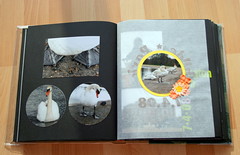

- Spotlight an element with a frame. Draw the viewer’s eye to a specific element in a photo by framing it. It adds a visual appeal and makes the photo speak for itself. You can use stamps, rub-ons, bling, chipboard or softies or anything else within your arm’s reach…
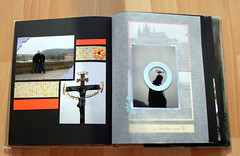
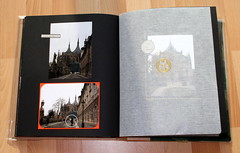
- Use extra photos to create a collage. There are some places or events that evoke special memories or deep emotions. I always pick too many pictures than I actually need to convey these memories and emotions (and sometimes I pick too many photos for printing for no reason at all). No problem, crop all the photos and piece them together into a collage.

- Turn to the pictures for design advice. Many times I take a picture because of the interesting composition I see in it. When the time comes to put this picture in a scrapbook, I repeat the same composition in my layout, either in the design or by the patterns of the paper I use.
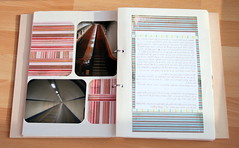
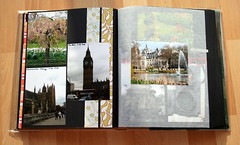
- Utilize the color scheme in your photos. Design your layouts around the colors in your photos. If your photos are monochromatic, you can have a go with a colorful and busy background; and vice versa, if your photos are colorful, you can do without any background.
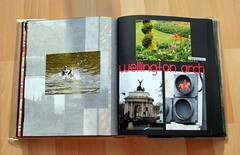
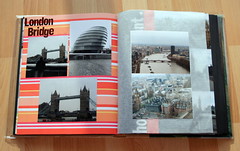
Use the color-wheel for inspiration and position complementary colored photos together.

- Most importantly – make sure to keep the process fun and easy. Don’t dwell on the design too much, just stick to some principle design elements and work around your mistakes without getting overwhelmed and frustrated. Scrapbooking “booboos” happen, so what? Remember the main reason you are scrapbooking for, I bet it isn’t self-bashing and over-criticizing…
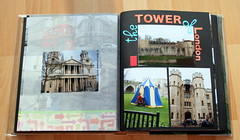
[In this layout I ran out of letter-stickers, so I used different types of stickers.]
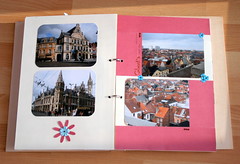
[In this layout I had an issue of a free-hand framing gone wrong, so I just covered it with cardstock. It does not look very appealing but I decided to just go on to the next page.]
I hope I have inspired you to start working on your life stories… the quick and easy way!!!
Enjoy!!!
If you have any question, suggestion or remark – don’t hesitate to contact me – either leave a comment, use the contact form or start a new thread on the Creativity Prompt Flickr Group!!!
I would also be very happy to see your own creations, so don’t be shy and share 🙂
Tags: creativity, creativity prompt, scrapbooking
Posted in creativity prompt | 6 Comments »
Friday, November 7th, 2008
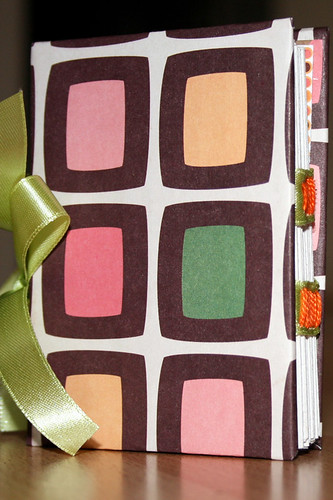 Next time you receive a package, don’t throw the box and the padding material away. Instead, turn them into a gorgeous hardbound journal, you can carry in your pocket.
Next time you receive a package, don’t throw the box and the padding material away. Instead, turn them into a gorgeous hardbound journal, you can carry in your pocket.
This tutorial is a recycled version of the extremely popular Hardbound Journal tutorial. You can find another variation here.
Supply –
- Two 2¾†by 3¾ “ cardboard pieces, cut from the box.
- 50 pieces of newsprint paper (used for padding packages) measured 5†by 3½ “.
- 4 scraps of patterned paper. Two measured 3¼†by 4¼†and two measured 2 5/8†by 3 5/8â€.
- Glue stick + double sided tape.
- Ribbon
- Embroidery floss
Tools –
Instructions –
- Flatten the box and cut 2 pieces, measured 2¾†by 3¾ “.

- Adhere the cardboard pieces to the larger scraps of patterned paper (3¼†by 4¼â€) with the glue stick. Position the cardboard pieces in the middle of each paper scrap (you can also use fabric scraps which are slightly larger). Cut the corners of the patterned paper flaps and allow an 1/8†gap between the edge of the cardboard to the base of the cut. Fold each flap and adhere it to the cardboard, using a bone folder.
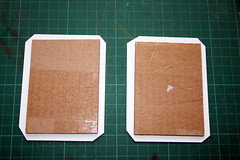
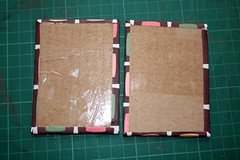
- Cut the newsprint paper to size (5†by 3½“) and fold each piece in half (creating 2½†by 3½†pages) – use a bone folder to insure a crisp fold. Stack every 5 pieces into one signature (altogether 10 signatures of 5 pages each).
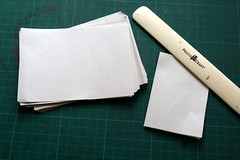
- Measure the height of the stack of signatures to determine the width of the spine.
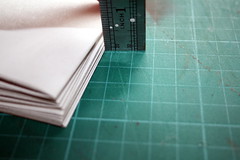
- Position the two covers apart from each other allowing the gap between them to equal the signatures’ height, as you have measured before. Using a double sided tape, adhere a strip of ribbon to both sides of the covers.
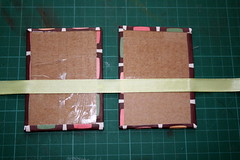
Mark the width of the ribbon on the signatures to figure out where to pierce them afterward.
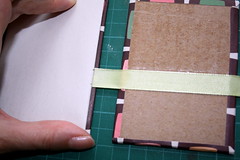
Repeat with a second strip of ribbon. The second strip will reinforce the journal and increase its stability.
- Secure the embroidery floss to the cover with a piece of tape and start sewing the signatures to the ribbon. Start from the outside of the ribbon, into the signatures and through the ribbon.
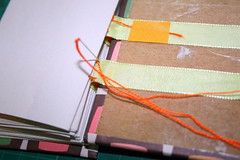
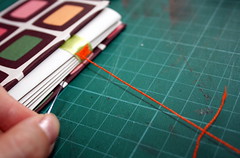
Take a peek at the finished spine –
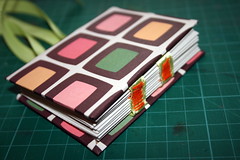
- Cover the inside of the journal with the 2 5/8†by 3 5/8†pieces of patterned paper to conceal the embroidery floss and give the journal a finished look. This is the time to trim the ribbon’s ends and cover them, if you don’t wish the ribbon’s ends to show.
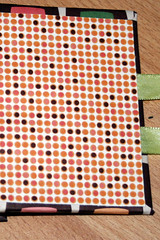
Here is how the journal looks without the ribbon’s ends –

Enjoy!!!
If you have any question, suggestion or remark – don’t hesitate to contact me – either leave a comment, use the contact form or start a new thread on the Creativity Prompt Flickr Group!!!
I would also be very happy to see your own creations, so don’t be shy and share 🙂
Tags: creativity prompt, journal tutorial, recycling, Tutorial
Posted in creativity prompt, Tutorial | 13 Comments »
Friday, October 31st, 2008
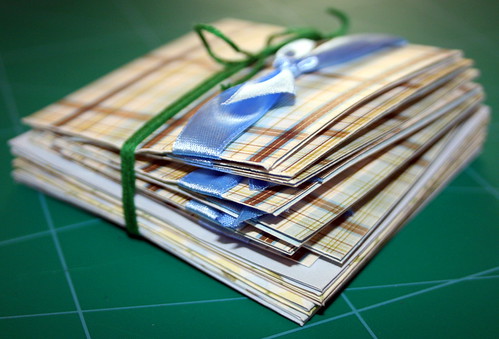
Many of my most cherished creations are a result of a blunder of some sort. After I pass the self bashing stage I try to make something out of the error and sometimes the result is far better than what I have originally planned to do.
Last week I have posted a tutorial on making a mini album out of a single sheet of cardstock. The process of making this mini album involves alternating cutting lines. I was trying to use the paper trimmer for the cutting and got confused and mistakenly cut the cardstock in the same direction.
Following my mistake the muse came to visit… I decided to make a bunch of 3″ by 3″ cards instead and also created a matching Envelope Template.
So, without further ado, here is the tutorial:
Supply –
Instructions –
- Cut the cardstock into 4 strips of 3″ by 12″ and then cut each strip in half to two pieces of 3″ by 6″ cardstock. Fold each piece in half, lengthwise, to create a cute 3″ by 3″ card. You will end up with 8 cards from the single sheet of cardstock.
- Use a craft knife to cut a ¾” slit into each card’s spine and weave the ribbon through. Tie the ribbon into a square knot and repeat on each card. [You are completely free to embellish the card in whichever way you wish… Don’t feel obligated to the ribbon, it won’t be offended – neither will I 😉 ]
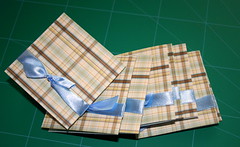
- Download the free envelope template and print it on a letter size paper (8.5″ by 11″). Cut the outline of the template. [You can either print it directly on the backside of the patterned paper or on a copy paper, which you can then cut and trace over the patterned paper – your choice].
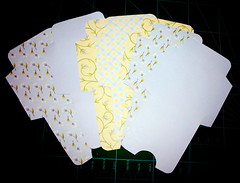
- Score along all the dashed lines of the template and fold. Adhere the long flap to the small side-flaps with a tape runner (or a glue stick, if you prefer…).

Easy, fun and adorable – my kind of a craft project 🙂
Enjoy!!!
If you have any question, suggestion or remark – don’t hesitate to contact me – either leave a comment, use the contact form or start a new thread on the Creativity Prompt Flickr Group!!!
I would also be very happy to see your own creations, so don’t be shy and share 🙂
Tags: crads, creativity, creativity prompt, template, Tutorial
Posted in creativity prompt, Tutorial | 4 Comments »





























































































 Next time you receive a package, don’t throw the box and the padding material away. Instead, turn them into a gorgeous hardbound journal, you can carry in your pocket.
Next time you receive a package, don’t throw the box and the padding material away. Instead, turn them into a gorgeous hardbound journal, you can carry in your pocket.





















